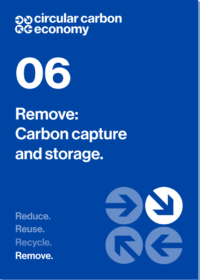Resources
Publications
Our publications, reports and research library hosts over 500 specialist reports and research papers on all topics associated with CCS.
View our Publication Library Disclaimer.
Filter by
The Economics of Direct Air Carbon Capture and Storage
26th July 2022
Topic(s): Carbon capture and storage (CCS), CO2 removals, Direct air carbon capture and storage (DACCS), Economics
Carbon capture and storage (CCS) is a set of technologies that capture CO2 from large emission sources or from the atmosphere and safely stores it underground or permanently in products. As the scale and urgency of climate action has become clearer in recent years and governments and companies have done the necessary work to map their own pathways to climate neutrality, carbon dioxide removal (CDR) technologies - direct air carbon capture and storage (DACCS) in particular - have become a focal point in climate mitigation.
This paper explores the economics of DACCS, relying on the economic model described in the methodology, in which actors within the energy system are free to pursue least-cost options in meeting net-zero pathways. The intent of the paper is a thought experiment to show how DACCS deployment might affect the global energy system. It focuses solely on the cost of DACCS - applying no additional policy assumptions - and is not a forecast.
The paper finds that:
- DACCS plays a unique role among technological climate mitigation options as it can function as a backstop technology, potentially avoiding climate disaster if other low-cost pathways are not realised.
- Low-cost DACCS, should it be realised, would reduce the total cost of decarbonisation and meeting climate goals.
- If DACCS deployment is limited due to high costs, the main decarbonisation pathway for industry and transport (except light duty vehicles, which are electrified) is hydrogen.
- Electricity generation, buildings, and light vehicles are largely unaffected by the deployment of DACCS and decarbonise through increased efficinecy and renewable energy pathways.
- The challenge inherent for governments is to implement policy and provide incentives for immediately available mitigation pathways, while supporting the development and commercialisation of lower-cost DACCS.
Download a description of the economic model used in this paper here.
Disclaimer
The content within the Global CCS Institute Publications, Reports and Research Library is provided for information purposes only. We make every effort and take reasonable care to keep the content of this section up-to-date and error-free. However, we make no claim as to its accuracy, currency or reliability.
Content and material featured within this section of our website includes reports and research published by third parties. The content and material may include opinions and recommendations of third parties that do not reflect those held by the Global CCS Institute.
CCS Networks in the Circular Carbon Economy: Linking Emissions Sources to Geologic Storage Sinks
5th October 2021
Topic(s): Carbon capture and storage (CCS), CCS networks
Carbon capture and storage (CCS) networks linking emissions point sources to a CO2 transport and storage hub is emerging as the lowest-cost and most cost-effective method of CCS development. As part of the Circular Carbon Economy: Keystone to Global Sustainability series with the Center on Global Energy Policy at Columbia University SIPA, this report reviews emissions and storage basins worldwide, seeking to link clusters of emissions-intensive regions to potential geologic storage basins.
The report is presented in two parts:
- In part one, using a single methodology to characterise global emissions and basins, the authors perform a high-level, regional analysis identifying potential CCS networks by linking suitable storage to intense emissions centres across the globe
- In part two the authors present a conceptual approach to designing a CO2 transport network from distributed sources to a target geological formation for storage, outlining the selection of gas-phase and dense-phase pipeline transport as well as an approach to minimising the cost of pipelines over the network.
Key findings from the report include:
- Potential CCS networks can be identified in almost every industrialised region of the world.
- Those potential networks identified in this report can guide future detailed investigation and planning required for CCS network development.
- Each industrialised region of the world has access to storage resources ranked as highly suitable or suitable.
- The combination of emission sources in proximity to storage sinks means a global portfolio of CCS networks is technically possible. These networks provide the greatest opportunity to rapidly decarbonise large clusters of power and industrial sources.
- Inadequate characterisation of geologic storage resources is the critical limiting factor to CCS network development across the globe.
- Comprehensive national assessments are still needed for the majority of nations. Until these assessments are completed, insufficient understanding of geologic storage resources will remain a significant barrier to CCS network development.
- Pipeline and compression networks require the development of cost models for piping and compression systems for the specific country and local costs of energy and construction. This provides the quantitative basis for decisions in network design.
Disclaimer
The content within the Global CCS Institute Publications, Reports and Research Library is provided for information purposes only. We make every effort and take reasonable care to keep the content of this section up-to-date and error-free. However, we make no claim as to its accuracy, currency or reliability.
Content and material featured within this section of our website includes reports and research published by third parties. The content and material may include opinions and recommendations of third parties that do not reflect those held by the Global CCS Institute.
CCS in the Circular Carbon Economy: Policy and Regulatory Recommendations
23rd July 2021
Topic(s): Carbon capture and storage (CCS), CCS finance, CCS investment, Policy law and regulation
CCS is one of many climate mitigating technologies that is mature, commercially available, and absolutely necessary to achieve global net-zero ambitions and a stable climate. The total installed CCS capacity must increase 100-fold by 2050 to limit global warming to below 2° Celsius.
This report summarises policy and legal factors that have a material impact on the investability of CCS projects and makes recommendations on how governments may facilitate greater private sector investment in CCS.
The report examines and covers:
- Financing CCS
- The development of CCS-specific legal and regulatory frameworks
- Recommendations addressing policy, finance and regulatory matters
Disclaimer
The content within the Global CCS Institute Publications, Reports and Research Library is provided for information purposes only. We make every effort and take reasonable care to keep the content of this section up-to-date and error-free. However, we make no claim as to its accuracy, currency or reliability.
Content and material featured within this section of our website includes reports and research published by third parties. The content and material may include opinions and recommendations of third parties that do not reflect those held by the Global CCS Institute.
Surveying the U.S. Federal CCS Policy Landscape in 2021
4th May 2021
Topic(s): Carbon capture and storage (CCS), CCS policy, Domestic policy, Policy law and regulation
2021 is proving to be a busy year for CCS policy in the United States. With the year not yet one third over, Members of the House of Representatives and Senate had already introduced five bipartisan bills that aim to accelerate the deployment of CCS. This brief details the contents of those bills and explains the rationale behind their policy proposals.
More broadly, though, Senior Advocacy & Communications Adviser, Matt Bright, uses this brief to examine the three pillars of CCS policy that undergird the advance of this technology in the U.S. In addition, this brief gives the reader a grand tour of U.S. CCS policy history from its inception to the present day in order to paint a complete picture of how strong policy can accelerate the deployment of CCS. In this way, the U.S. CCS policy landscape can be viewed as a lens to magnify the challenges and opportunities that lie ahead for global CCS deployment in the coming decades.
Disclaimer
The content within the Global CCS Institute Publications, Reports and Research Library is provided for information purposes only. We make every effort and take reasonable care to keep the content of this section up-to-date and error-free. However, we make no claim as to its accuracy, currency or reliability.
Content and material featured within this section of our website includes reports and research published by third parties. The content and material may include opinions and recommendations of third parties that do not reflect those held by the Global CCS Institute.
Technology Readiness and Costs of CCS
29th March 2021
Topic(s): Carbon capture and storage (CCS), Technology readiness
Carbon Capture and Storage (CCS) are essential technologies to help achieve net zero ambitions. The cost of deployment of CO2 capture, transport and storage systems is of vital economic and environmental importance. This importance will continue to increase as the scale and breadth of CCS deployment grows around the world.
As part of the Circular Carbon Economy: Keystone to Global Sustainability series with Columbia University's SIPA Center on Global Energy Policy, this report examines CCS technology from two perspectives: technology readiness and factors influencing costs.
Key drivers of CCS cost include:
- Economies of scale;
- Partial pressure of CO2 in the source gas;
- Energy costs; and
- Technological innovation.
Mature and emerging technologies in carbon capture, transport and storage are surveyed for technological readiness. Technological development will be a key element of driving future cost reductions in CCS and applying CCS to hard-to-abate sectors such as cement, steel and direct air capture.
Disclaimer
The content within the Global CCS Institute Publications, Reports and Research Library is provided for information purposes only. We make every effort and take reasonable care to keep the content of this section up-to-date and error-free. However, we make no claim as to its accuracy, currency or reliability.
Content and material featured within this section of our website includes reports and research published by third parties. The content and material may include opinions and recommendations of third parties that do not reflect those held by the Global CCS Institute.
Carbon Removal with CCS Technologies
26th January 2021
Topic(s): Carbon capture and storage (CCS), Carbon removal, CCS policy, Negative emissions technologies, Policy law and regulation
With the transition to a low-carbon economy steadily underway, CCS is becoming recognised as a tool that complements the wide array of climate approaches being utilised to reach climate neutrality. The role of emission reductions and removals in the mitigation of climate change will change over time. It is widely agreed that emission reductions should be prioritised on the pathway to net zero. This, however, will change once net zero emissions are achieved; net zero is a point on the journey, not the final destination. Carbon removal will become the main driver of climate ambition in the second half of the century.
In this brief, Senior Policy Advisor with the Global CCS Institute, Eve Tamme, explains the dual role of CCS in climate change mitigation, and provides an overview of the two technological carbon removal approaches that use CCS: bioenergy with carbon capture and storage (BECCS) and direct air capture with carbon storage (DACCS). Along with highlighting the varied applications of CCS, this brief also includes a summary of ongoing challenges and opportunities tied to carbon removal related policy development.
Disclaimer
The content within the Global CCS Institute Publications, Reports and Research Library is provided for information purposes only. We make every effort and take reasonable care to keep the content of this section up-to-date and error-free. However, we make no claim as to its accuracy, currency or reliability.
Content and material featured within this section of our website includes reports and research published by third parties. The content and material may include opinions and recommendations of third parties that do not reflect those held by the Global CCS Institute.
Replacing 10% of NSW Natural Gas Supply with Clean Hydrogen: Comparison of Hydrogen Production Options
17th November 2020
Organisation(s): Global CCS Institute
Topic(s): Australia, Carbon capture and storage (CCS), Hydrogen
Clean hydrogen is produced by either using renewable energy to produce green hydrogen, or by using fossil fuels with carbon capture and storage (CCS) to create blue hydrogen.
As part of determining the most cost-effective method of creating clean hydrogen, Coal Innovation NSW (CINSW) commissioned the Global CCS Institute to investigate the production costs of replacing 10 per cent of NSW’s natural gas supply with clean hydrogen.
The study considers a scenario where sufficient clean hydrogen is produced to achieve a 10% H2:90% CH4 (natural gas) mix by volume in the NSW gas network and supply the same total energy as is currently supplied by natural gas alone. Options considered were reformation of natural gas with carbon capture and storage (CCS), coal gasification with CCS, and electrolysis of water using renewable electricity. The study found that the best option for the production of clean hydrogen in NSW considering cost, scale, resource use, and emissions abatement outcomes is to utilise coal or gas with CCS.
See NSW Government for further information
Disclaimer
The content within the Global CCS Institute Publications, Reports and Research Library is provided for information purposes only. We make every effort and take reasonable care to keep the content of this section up-to-date and error-free. However, we make no claim as to its accuracy, currency or reliability.
Content and material featured within this section of our website includes reports and research published by third parties. The content and material may include opinions and recommendations of third parties that do not reflect those held by the Global CCS Institute.
Remove: Carbon Capture and Storage
2nd November 2020
Organisation(s): Global CCS Institute
Topic(s): Carbon capture and storage (CCS), CCS policy
Ahead of the 2020 G20 summit, the Global CCS Institute was asked to contribute to the Circular Carbon Economy (CCE) Guide, organised by KAPSARC. In a report titled 'Remove: Carbon Capture and Storage', Alex Zapantis assesses the value of CCS as an effective climate mitigating technology that aims to remove CO2 from the atmosphere and support the establishment of a circular carbon economy.
The report was discussed during a live webinar hosted by KAPSARC.
To read the report in full, click download below.
Disclaimer
The content within the Global CCS Institute Publications, Reports and Research Library is provided for information purposes only. We make every effort and take reasonable care to keep the content of this section up-to-date and error-free. However, we make no claim as to its accuracy, currency or reliability.
Content and material featured within this section of our website includes reports and research published by third parties. The content and material may include opinions and recommendations of third parties that do not reflect those held by the Global CCS Institute.
Is CCS expensive?
30th May 2020
Organisation(s): Global CCS Institute
Topic(s): Carbon capture and storage (CCS), Cost
Carbon capture and storage (CCS) is needed as part of the toolkit of technologies to achieve net-zero emissions by mid-century. Yet, texts and commentary about CCS often include qualifiers that are related to the expenditures necessary to deploy it; ‘costly’, ‘exorbitantly expensive’, ‘unaffordable’, ‘uneconomical’. As such, the argument most often brought forward against deployment of CCS is that it is an expensive way of reducing emissions.
This brief written by our Senior Advisors for Advocacy and Communications Lucy Temple-Smith and Lee Beck demonstrates that:
- To reach net-zero emissions by mid-century and achieve global climate change targets all decarbonisation options are needed.
- Carbon capture and storage (CCS) plays an important role reducing emissions to net-zero and limiting the overall system cost of decarbonisation.
- With versatile applications, CCS cost differs across its variety of industrial and power-related applications – there is no singular cost of CCS.
- Considering the urgency of the climate crisis, cost should not be a deterrent to investing in CCS nor dictate sequencing of the deployment of decarbonisation options. Instead, deployment will lead to cost reductions.
- A value on carbon is needed to support the business case for large-scale CCS deployment and overcome the technology ‘valley of death’.
Disclaimer
The content within the Global CCS Institute Publications, Reports and Research Library is provided for information purposes only. We make every effort and take reasonable care to keep the content of this section up-to-date and error-free. However, we make no claim as to its accuracy, currency or reliability.
Content and material featured within this section of our website includes reports and research published by third parties. The content and material may include opinions and recommendations of third parties that do not reflect those held by the Global CCS Institute.
CCS Development in Southeast Asia
25th May 2020
Organisation(s): Global CCS Institute
Topic(s): Carbon capture and storage (CCS), Carbon capture use and storage (CCUS), Southeast Asia
In recent decades, Southeast Asia has been one of fastest growing regions of the world. Its energy demand has grown more than 80 per cent from 2000. Oil, coal and gas provides more than 70 per cent of its energy. With the region's power generation fuel mix and rapidly growing natural gas production, alongside established and emerging emissions reduction committments, CCS has a unique and critical role to play.
In this paper, Institute’s Senior Client Engagement Lead Dr Tony Zhang, discusses why Southeast Asia needs CCS, the specific drivers behind the opportunities for accelerated deployment and the critical role of CCS hub and cluster networks in reducing the region's emissions.
Disclaimer
The content within the Global CCS Institute Publications, Reports and Research Library is provided for information purposes only. We make every effort and take reasonable care to keep the content of this section up-to-date and error-free. However, we make no claim as to its accuracy, currency or reliability.
Content and material featured within this section of our website includes reports and research published by third parties. The content and material may include opinions and recommendations of third parties that do not reflect those held by the Global CCS Institute.
The Value of Carbon Capture and Storage (CCS)
13th May 2020
Organisation(s): Global CCS Institute
Topic(s): Carbon capture and storage (CCS), Economic growth, Employment, Industrial CCS, Jobs
The new flagship Global CCS Institute thought leadership report analyzes the major benefits of the large-scale investment and deployment of CCS and discusses the existing evidence related to the value of CCS under two overarching themes.
CCS as an essential technology to economically meet long-term climate targets and for risk mitigation through:
- Achieving deep decarbonisation in hard-to-abate industry;
- Enabling the production of clean hydrogen at scale;
- Providing low-carbon dispatchable power;
- Delivering negative emissions.
CCS is a driver of economic growth and employment by:
- Creating and sustaining jobs;
- Supporting economic growth through new net-zero industries and innovation spillovers;
- Facilitating a just transition by alleviating geographic and timing mismatches;
- Enabling infrastructure reuse and deferral of decommissioning costs.
This report was authored by the Institute's Senior Consultant - Economics Alex Townsend and Research Analyst Nabeela Raji, as well as the Institute's General Manager - Commercial, Alex Zapantis. You can tweet about the report using #ValueCCS.
Disclaimer
The content within the Global CCS Institute Publications, Reports and Research Library is provided for information purposes only. We make every effort and take reasonable care to keep the content of this section up-to-date and error-free. However, we make no claim as to its accuracy, currency or reliability.
Content and material featured within this section of our website includes reports and research published by third parties. The content and material may include opinions and recommendations of third parties that do not reflect those held by the Global CCS Institute.
CCS: Applications and Opportunities for the Oil and Gas Industry
7th May 2020
Organisation(s): Global CCS Institute
Topic(s): Carbon capture and storage (CCS), Energy, Oil and gas, Transition
As oil and gas companies are evolving their business models in the context of the energy transition, and a growing number of them are committing to net-zero targets, CCS has started to feature more prominently in their strategies and investments.
In this paper, Institute’s General Manager Guloren Turan discusses how CCS can support the oil and gas industry’s low-carbon transition and addresses current developments and opportunities in applications including gas processing, enhanced oil recovery, ethanol production, refining, low-carbon hydrogen production, gas-fired power generation, and direct air capture.
Disclaimer
The content within the Global CCS Institute Publications, Reports and Research Library is provided for information purposes only. We make every effort and take reasonable care to keep the content of this section up-to-date and error-free. However, we make no claim as to its accuracy, currency or reliability.
Content and material featured within this section of our website includes reports and research published by third parties. The content and material may include opinions and recommendations of third parties that do not reflect those held by the Global CCS Institute.











